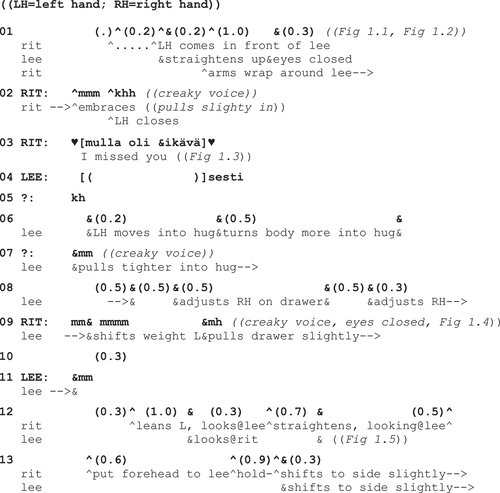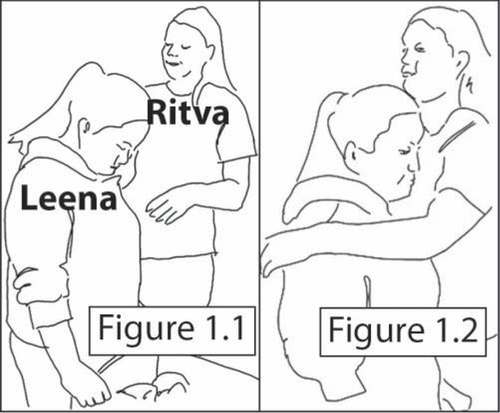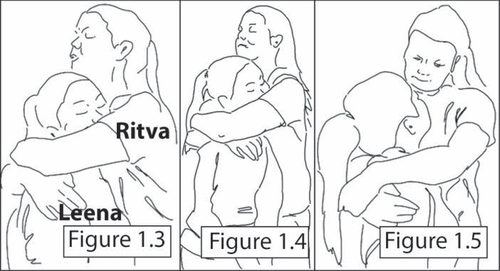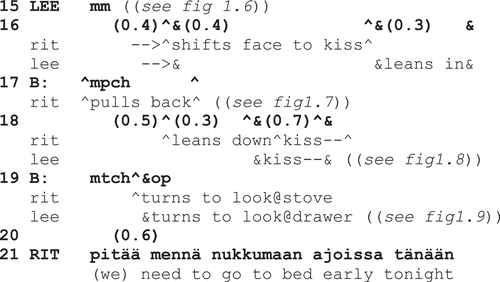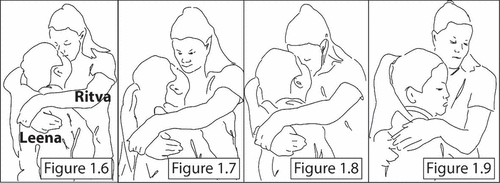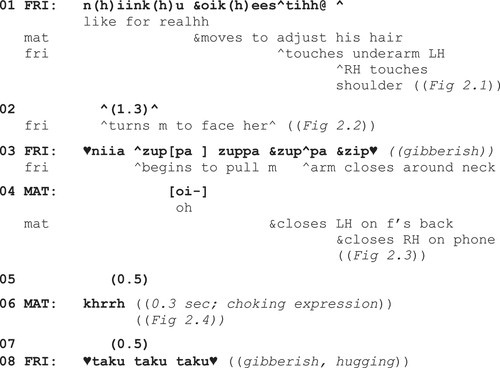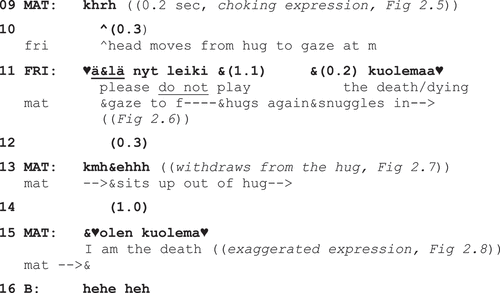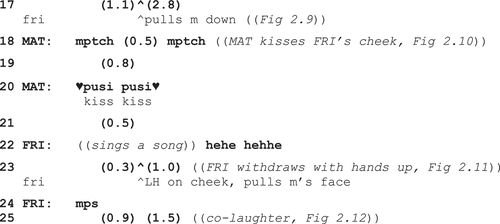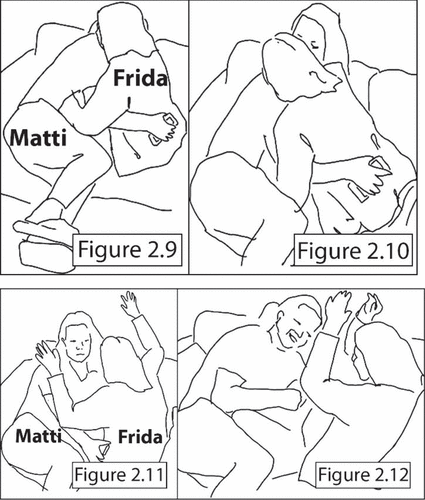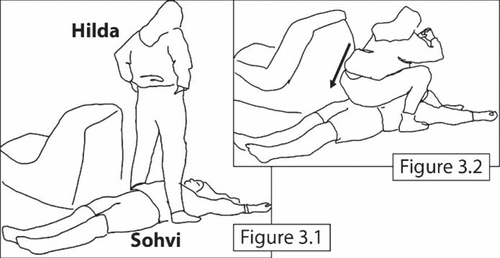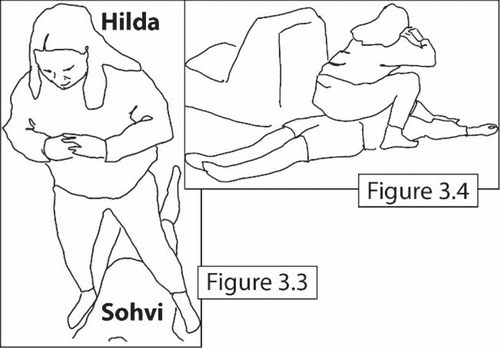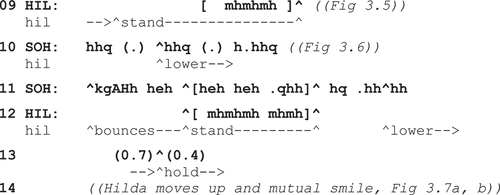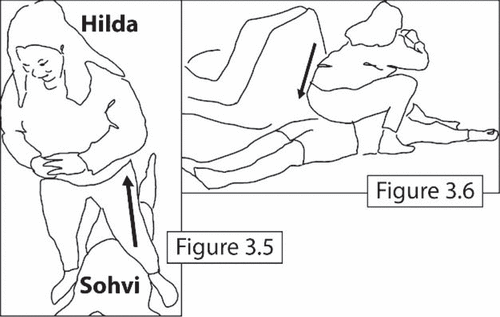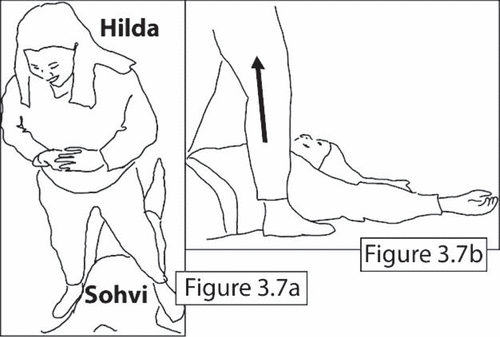ABSTRACT
Research on interaction has recently ventured into the domain of sensoriality, hitherto considered inaccessible for video analysis. This article contributes to this emerging field by targeting the interface of touch and vocal sound, dissecting the intersubjective potential of sounding when bodies are intertwined. Studying naturally occurring affective episodes between romantic partners at their homes with the methods of multimodal interaction analysis, we demonstrate how vocalization can express comfort and thus lead to extension of mutual bodily contact, or inform of discomfort, which leads to swift release of the problematic contact. We argue that, by providing immediate and nuanced access to other participants’ ongoing bodily experiences, haptic sensoriality is partially distributed into the auditory domain. The relevance of progressivity in body contact is continuously negotiated and has moral, social, and relational implications, providing grounds for continuous realization of consent. Data are in Finnish.
Introduction
Interpersonal touch is a means for communicating affect in intimate relationships (Goodwin & Cekaite, Citation2018; Hertenstein, Citation2002, p. 200; Montagu, Citation1971). In this article “affect” is used as an overarching term, including both “emotions” and “feelings” (Roald et al., Citation2018, p. 206) and the verb “to affect” as influencing someone else in this regard. During interpersonal touch, participants are simultaneously affecting and being affected. Accordingly, touch can be “transformative” for both parties (Edvardsson et al., Citation2003; Maclaren, Citation2014), although it is impossible to literally experience how touch feels in another body. In this study, we will explore how vocalizations are deployed as a communicative resource during multisensorial interactions among romantic couples. We aim to demonstrate not only that touch does not occur in a vacuum of other multisensory resources, but also that vocalizing is an informative component of touching and communicates affect.
Touch occurs within concrete interactional trajectories that may involve facial displays, spatial closeness, body movements, and vocal utterances. While faces can certainly provide clues about how a touch feels, during extensive tactile-bodily entanglements, other persons’ faces are not necessarily available. We document the communicative potential of vocal behavior in tandem with touch. Since the vocal tract is part of the body and its muscles are variably engaged in performing verbal or other actions (Keevallik & Ogden, Citation2020), specific qualities of vocal production can provide immediate cues regarding what the body is currently undergoing (Hofstetter et al., Citation2021). Furthermore, when vocal actions are produced together with touch, they may guide the recipient on how the touch is interpreted.
We target sounds of the body that ostensibly arise from ongoing corporeal experiences, similar to “response cries” described by Goffman (Citation1981, pp. 99–108). The focus vocalizations are produced amid body-to-body touch or as an immediate response to them. We show how these sounds are understood as commenting on touch. Using interaction analysis of naturally occurring video-recorded interactions as our method (Streeck et al., Citation2011), we illustrate how both sound and touch are treated as meaningful and consequential for progressing the activity. Partially through vocalizations, the participants negotiate whether to continue or terminate the touch. Contributing to the line of studies on interaction among intimates (Goodwin, Citation2017; Goodwin & Cekaite, Citation2018; Katila, ; Katila & Cekaite, Citation2023; Mondada et al., Citation2020), we suggest that sounds play a role in embodying affect that emerges in and through touch in everyday intimate interactions.
Meaning potentials of touch in intimate relationships
Given its transformative power, touch can influence people in manifold ways. We know most about its beneficial aspects: Touch is not only crucial for creating and maintaining social bonds but also vital to our health and well-being (Field, Citation2014). Considerably less is known about the problematic effects of touch (Gallace & Spence, Citation2010, p. 250), even though the influences of unwanted touch can be long-lasting; for example, an analysis of written biographies showed that disturbing touch can be a source of lifelong trauma (Kolehmainen & Kinnunen, Citation2019). Touching brings the physicality of bodies (their form, strength, and movement) to the fore, as touching always implies exerting a certain amount of force on another person’s body; even well-meaning touch can potentially cause pain or feel uncomfortable for the recipient. For instance, physical contact meant as diagnostic, healing, or curing can momentarily cause pain or hurt, such as during a massage (Kuroshima, Citation2020) or when clinicians conduct procedures or test the patient’s body for tenderness through touch (e.g., McArthur, Citation2019; Weatherall et al., Citation2021). Furthermore, touch need not be painful to be interpreted as inappropriate. For instance, in their study considering touch in classroom interactions between children aged between 7 and 15 years, Karvonen et al. (Citation2023) found that types of touch commonly regarded as affectionate—such as caressing, stroking, and tapping—could be interpreted by the recipient as distracting their bodily integrity or disturbing the engagement in pedagogical activities. Or, in the context of nursing, studies indicate that male nurses sometimes avoid touching their patients because they fear it may be interpreted as sexual (for a review, see Kelly et al., Citation2018).
Romantic relationships are a special place for touch to occur; unlike parent–child or practitioner–patient touch, in romantic relationships, physical contact is involved in expressing romantic love and possible sexual intimacy. Such relationships entail (at least ideally, and again unlike many other relationships) two adults voluntarily choosing to share their affective lives with a specific individual. Therefore, communicating that one does not want to be touched by one’s partner or that the partner’s touch feels uncomfortable can be highly consequential. The complexities of harmful touch in romantic relationships have been explored especially by studies on domestic violence; touch (among other forms of domestic violence) can produce tremendous harm in close relationships (Smith Stover, Citation2005), as well as emotions such as shame (Husso, Citation2003; Lidman, Citation2021). However, observational studies on how participants actually negotiate touch in nonviolent intimate relationships are still nonexistent.
In regard to harmful or unwanted touch in a sexual context, sexual consent and legislation against unwanted touch have been debated at length (e.g., Halley, Citation2016). A key principle is bodily autonomy; the idea that everyone should have the right to decide who has access to their own body and how that access is exercised (Popova, Citation2019, pp. 13–14). One common theory about consent is called the affirmative consent model, which describes affirmative, conscious, and voluntary agreement to engage in sexual activity. Silence or lack of resistance cannot be interpreted as consent (Muehlenhard et al., Citation2016). However, many studies have pointed out the ambiguity of such guidelines in real-life situations, as they leave room for interpretation regarding various verbal and nonverbal behaviors (Coy et al., Citation2016; Magnusson & Stevanovic, Citation2023; Muehlenhard et al., Citation2016).
Establishing sexual consent is a nuanced and context-specific matter (see Burkett & Hamilton, Citation2012, for a critical discussion; Gronert & Raclaw, Citation2019; Holmström et al., Citation2020). Instead of “just saying no,” successful refusals are complex social actions that may involve several different strategies, including, perhaps surprisingly, compliments, silences, and weak acceptances (Kitzinger & Frith, Citation1999). A recent study by Magnusson and Stevanovic (Citation2023) analyzed the interactional emergence of consent during sexual initiations in scripted media—contemporary TV series and movies—finding they often occurred through nonexplicit and embodied means. Other interaction studies have explored touch in unscripted, naturally occurring everyday encounters, looking at how participants negotiate whether to touch or not, for instance, among parents and children (Goodwin & Cekaite, Citation2018; Katila, Citation2018), romantic couples (Katila, ; Katila & Cekaite, Citation2023), therapeutic massage (Nishizaka, Citation2016), or between students in couples dance classes (Keevallik, Citation2020). However, studies on how affect occasioned by touch is communicated in close relationships, are, to our knowledge, nonexistent, despite the importance of this question for understanding how consent among partners in mundane contexts is achieved.
Our investigation on the video-recorded, naturally occurring interactions of couples aims at addressing this research gap; we look at the organization of touch in romantic couples’ homes. In our dataset, no violence or abuse was witnessed, which may reflect prevailing social norms and self-policing by participants. However, what can be observed is a vivid, constantly changing, and context-dependent continuum of appreciated and unwanted touch, the distinction between which may be a sensitive matter to communicate even in secure romantic relationships. By scrutinizing nonlexical vocalizations that are co-performed with tactile intertwinements, we can witness a subtle and ongoing embodied negotiation over the implications of touch, especially regarding whether it should be continued or terminated. We are thus exploring another alternative to the “just say yes or no” strategy—one that is more germane to how people actually practice their intimate relationships.
Intercorporeality and multisensoriality of affective encounters
While touching occurs in a range of settings, arguably the most extended and varied forms of interpersonal touch take place in close relationships. As an animal species, humans are endowed with a primordial intersubjective tendency (Levinson, Citation2006; Trevarthen & Aitken, Citation2001) and are wired to engage in affective communications with their caregivers from the day they are born. Touch is a crucial means for such emerging intercorporeal communication, and it has been shown to play multiple communicative functions, from nurturing, to play, to attention-getting touch (e.g., Jean & Stack, Citation2009). Moreover, we are currently learning how sounds feature during touch, such as in manipulations of infant bodies during, for example, diaper changing (Nomikou, Citation2023).
Other multisensorial resources, such as a special tendency to recognize faces (Slater, Citation2002) and participate in vocal “protoconversations”—that is, the matching vocal exchanges between infants and their caregivers (Trevarthen, Citation1979)—are also present and co-emerge with touch and bodily gestures from the very beginning of a human’s life (e.g., Rączaszek-Leonardi et al., Citation2022). The primacy of embodied communication during intimate, affectionate encounters pertains beyond infancy. For instance, among romantic couples, it has been established that affectionate touch, including kissing, is associated with greater well-being (Debrot et al., Citation2021) and can increase relationship satisfaction (Gulledge et al., Citation2003). Forms of affectionate touch can take infinite forms, including routine kissing and hugging when leaving or entering home (Goodwin & Cekaite, Citation2018) but also spontaneous intimate interactions resulting in affectionate touch (Katila & Cekaite, Citation2023).
Occurring between “living bodies” (Streeck, Citation2013), interpersonal touch is inherently intercorporeal. The concept of intercorporeality (Merleau-Ponty, Citation1962, Citation1964, Citation1968) refers to the co-experienced, embodied, and interaffective aspect of meaning-making. Touch enables direct communication via the bodies in “flesh,” thus being a primal aspect in connecting bodies with the world (Merleau-Ponty, Citation1968, p. 139); “It is as if the other person’s intention inhabited my body and mine his” (Merleau-Ponty, Citation1962, p. 185). However, touch does not automatically guarantee intersubjective understanding. Despite sensation being distributed across participants (Goodwin, Citation2017; Mondada, Citation2021; Di Paolo et al., Citation2018), the affect involved in touch is partly inaccessible to others. Besides the visual modality (Mayo et al., Citation2018), vocalizations can play an important role in communicating affect. Targeting the reciprocal features of mother–child encounters, a range of studies have suggested that they are characterized by rhythmic, even musical features (Chen, Citation2022; Gratier & Apter-Danon, Citation2009; Trevarthen, Citation2012). When parents and their children kiss or hug each other, the participants often deploy a special, affectively laden creaky voice (Goodwin & Cekaite, Citation2018, p. 152). Romantic partners often accompanied their hugs with mmm-sounds to display pleasure (Katila & Cekaite, Citation2023). Goodwin and Cekaite (Citation2018, pp. 128–129) analyzed ways in which “bodies make music together” and co-create rhythmic patterns in a touching sequence between a parent and a child. Thus, vocalizations can create the affective tone of the situation, thereby enabling the participants to unite into a co-sensing “us” (Hofstetter & Keevallik, Citation2023; Weatherall et al., Citation2021).
Vocalizations at the interface of the sensorial and the social
The conceptualization of emotions and sensations as purely individual and nonsocial—that is, as direct reflections of “inner” processes (Darwin, Citation1872; Ekman & Friesen, Citation1969)—has become growingly problematic. Likewise, the challenge of finding stable meanings for expressive vocalizations can be seen in studies that attempt to determine the meanings of these sounds based on acoustic measures, for example, by asking listeners to categorize their instrumentally manipulated versions outside any context or embodiments (Anikin, Citation2020). Some studies have even argued that different basic emotions can be distinguished through specific combinations of acoustic features, such as amplitude, pitch, and spectral profile (Sauter et al., Citation2010). However, even based on controlled experiments, there is significant acoustic similarity between “grunts of disgust and moans of pleasure” (Anikin, Citation2020, p. 1256), which suggests there is more to their distinctiveness than their phonetics.
Vocal tract sounds demonstrably make sense in their multimodal context, as people publicly display their understanding of various vocalizations in real-life situations (Keevallik & Ogden, Citation2020). According to Goffman’s pioneering work (Goffman, Citation1955, Citation1961), sounds and nonlexical vocalizations are an important means for expressing the body’s ongoing affect and sensations. Goffman (Citation1978) referred to interjections such as Oops!, Ahh!, and Eeuw! as “response cries” (p. 800). These sounds of the body, marking a natural overflowing of bodily feelings and sensations (Goffman, Citation1961, p. 50, Citation1978, p. 800), not only enable communication about one’s bodily concerns in social space but also provide the means of organizing accountability, such as displaying oneself as able to account for any momentary failure to control one’s own body. The data of our study feature a range of naturally occurring and ecologically contextualized phonetic variations, revealing how they provide a local resource for participant meaning making.
Since the work of Goffman, interaction studies have adopted a fundamentally social view on displays of affective states. In recent years, the social organization of sensoriality has become a topic of lively discussion (Goico et al., Citation2021; Goodwin & Cekaite, Citation2018), with studies showing, for instance, the interpersonal organization of taste, smell, and touching of objects (Mondada, Citation2021). Following this line of scholarship, we do not treat bodily expressions––especially, in our case, vocalizations––as mere results of inner feelings, but as potential actions of interactional value. Previous studies have established, for instance, that pain displays (Jenkins, Citation2015; Weatherall, Citation2023; Weatherall et al., Citation2021), sounds of gustatory pleasure and disgust (Wiggins, Citation2013; Wiggins & Keevallik, Citation2021, Citation2023), crying (Burdelski & Cekaite, Citation2020; Hepburn & Potter, Citation2012), sounds of effort at a gym (Grahn et al., Citation2023; Reynolds, Citation2017), sounds of working in the sheep stable (Keevallik, Citation2023), and playfully disappointed moans during board games (Hofstetter, Citation2020) are all accountable for their timing and genuineness, and contribute to the unfolding interactional projects of the participants. On a broader scale, this line of research supports the conceptualization of language and vocal behavior as inherently dialogic (Linell, Citation2009): People can even sound for others’ ostensibly individual sensations, such as expressing the pain and strain in other bodies (Keevallik et al., Citation2023).
Regardless of the omnipresent effects of social norms, neither our bodies nor their sounds are always under our control. In Goffman’s (Citation1956) words, when in each other’s co-presence, participants constantly both give and give off information (p. 2). In situations of extreme pain or pleasure, the demands of the body can overtake our ability to participate in the interaction order (Hofstetter et al., Citation2021). Often the sound expressions linger somewhere between the controlled and orderly, and uncontrollable and disorderly. As suggested by Dingemanse (Citation2020, p. 191), because “they equivocate between showing and saying, giving off and giving, symptoms and symbols,” nonlexical vocalizations could be referred as “liminal signs”—that is, as potential sources of meaning-making. Given this special quality, we will show how these sounds emerge as the bodies’ expressions of their affective livingness in touch.
The role of vocalizations will here be explored in intimate tactile intertwinements. By documenting nonlexical as well as lexical expressions alongside touch, we discuss the uses and advantages of different vocal resources in a real-life context.
Materials and methods
The data consist of video recordings of the naturally occurring episodes of 10 homo- and heterosexual couples at their homes in Finland. The first author collected the data from each couple, who recorded for seven days for 10–20 hr a day with four or five video cameras set up in different rooms (the living room, kitchen, dining room, hallway, and bedroom). Videoclips of the couples’ interactions were shown to the participants as part of interviews about their own interpretations of those events, which provides some background to the videos. The Tampere Region Ethical Committee of Human Sciences approved of the study setup, and each participant provided a written consent (for details, see Katila, ; Katila & Cekaite, Citation2023). Names are pseudonyms.
The collection for this study consists of nonlexical vocalizations made during affective touch. The three episodes selected for discussion are representative of the observed variations in the tactile-vocal affective practices. While affectionate touch can also occur silently, most often tactile-affectionate trajectories were accompanied by a type of vocalization, or a kissing sound of the kind that inevitably emerges from touching lips (see Katila & Cekaite, Citation2023). This in itself demonstrates the inherently multisensorial nature of body-to-body touch. The transcription conventions are drawn from Mondada (Citation2018, see ). In addition to more conventionalized transcription signs, we have adopted the symbol ♥ to indicate speech produced with a partner-directed, affectionate voice. Photoshop was used to produce the accompanying drawings, which depict still images from the relevant moments in the video recordings.
We use detailed video analysis (e.g., Streeck et al., Citation2011) to document the minute evolution of interactional episodes and the precise coordination of various interactional resources, such as gaze, gesture, and movement in space.
Analysis
In the following analysis, we will illustrate how romantic partners engaging in intimate touch use various types of vocalizations to enact a range of sensations, from pleasure to pain.
Vocalizing pleasure during touch
exemplifies how the pleasure of hugging is enacted with gentle vocalizations. We suggest that aural vibrations provided by mmm-sounds, resonating with a body-to-body touch, help the participants to co-inhabit the affectionate moment as well as navigate the temporality of the touch. The participants, whom we call Ritva and Leena, have been together for four years. It is a weekday and they have just gotten home and started cooking.
Extract 1, Part 1: Vocalizing pleasure
As Ritva and Leena enter into a hug (, Line 01), Ritva vocalizes with a creaky and low-pitched “mmm khh” in time with pulling tighter into Leena (Line 02): a lengthy bilabial nasal sound followed by an outbreath. This vocalizing is repeated with a further tightening of the embrace (Line 07), and a shift in weight (Line 09). The sounds are thus co-produced with the participants’ bodies moving into tighter intertwining. This reflects the fact that they are partly “natural” byproducts of a body under pressure: Air is squeezed out of the lungs, but the body also produces (gentle) muscle tension as a means of displaying active participation. As air is squeezed past activated muscles, vocalizations can be produced by tensing the vocal folds. In this case, the participants produce the quiet mmm-sounds by minimizing the overall engagement of the articulatory system—the lips are not tense—contributing to the sense of relaxing into each other. In real interaction, mechanical body responses and utterance design are inseparable; the participants produce these sounds by adopting particular bodily intertwinements, and the intertwinements contribute to producing the sounds. The “living bodies” (Streeck, Citation2013) of the participants are physiological, sensing, and communicating inextricably all at once.
Extract 1, Part 2: Vocalizing pleasure
An “mm” is also used when the couple brings their foreheads together (Line 15, ), reestablishing touching after a moment in face-to-face formation (Lines 13–14, ). The fact that we as analysts had difficulties assigning the bilabial sounds and outbreaths to a specific speaker (e.g., Line 07) illustrates the mutuality of hugging practice, where it is not always clear who is acting on whom (even though the participants themselves can sense who is vocalizing). Notably, when the couple has visual access to each other’s faces, they do not vocalize. The sounds are especially produced at moments of close intertwinement.
The mmms in this excerpt are reminiscent of vocalizations used to appreciate food (Wiggins, Citation2002), although this is only one conventionalized way of using the bilabial sound. An mmm can index different things, depending on its position in sequences and its prosodic qualities (Gardner, Citation2001). Here, the low volume and low (Lines 02, 07) or high-low (Line 09) pitch suggest the participants design the token for their extremely close recipient and to avoid indicating discomfort in the bodies that lean into each other. The sounds index the pleasure of squeezing and being squeezed, partly through creaky voice (also noticed in Goodwin & Cekaite, Citation2018, p. 152), achieving intimate “compresence” (Merleau-Ponty, Citation1964, p. 168). The appreciative mutual vocalizing during the squeeze projects prolongation of the hug, as each mmm is followed by a period of holding the embodied configuration (Lines 03, 07, 09, 11, and 13–15; , ). The vocalizations thereby perform a kind of incremental consent, making relevant a continuation or progression of the event (see also Katila & Cekaite, Citation2023).
shows how mutual acceptance, if not enjoyment, of getting into a close bodily intertwining, is not only performed by the bodies via touch but also calibrated through the vocal means. The mmms belong to the intercorporeality of the hug, performing the multisensorial event as shared across the participants’ bodies. It is in this way that vocalization, embedded in the tactile experience, constitutes a medium for communication about a shared “affective stance” (see Goodwin et al., Citation2012) toward the hug, and how the touch currently feels. Importantly, the similarity of the produced vocalizations of the participants makes an alignment between hugger and huggee publicly available: Both enact feeling the same way. The stance may not be as explicitly formulated as in verbal assessments, but the participants take it as transparent that they are alike in their affectual performance of the hug. As we will show in the next sections, sounds can likewise produce an event as uncomfortable.
Vocalizing discomfort during touch
Vocalizations are also used to display discomfort, either playfully or not, and make it relevant for the tactile activity to stop. In this section, we discuss an example in which vocalizations become part of negotiations about progressing the activity. During a hug with an arm touching the throat, a participant whom we call Matti produces a soft choking sound which his partner, whom we call Frida, treats it as playful, while also attending to the possibility of Matti’s discomfort. As begins, the couple, together for six years, are spending their free time on a Saturday afternoon relaxing on the sofa. The two choking sounds in this extract (Lines 06, 09) balance displaying discomfort but co-occur with Matti not actually withdrawing himself from the situation, thus not signaling real urgency in suffocating.
Extract 2, Part 1: Vocalizing discomfort
In Line 03, while Frida is producing affectionate gibberish sounds, the participants establish a hug with Frida’s arm around Matti’s throat (). Matti’s choking sound in Line 06 and indexes trouble with breathing. It treats the hug as inappositely arranged and needing amendment, and the speaker as a passive recipient of the hug. Like in Extract 1, the vocalization is ostensibly a result of a pressure on the body and thus informative of its current state. However, since it can also be uttered without any physical impact, the laryngeal sound is usable as a purely performative device. In the current sequential context, with Frida producing gibberish sounds, it is fully possible to treat Matti’s first choking sound as a legitimate contribution to a playful sound sequence (Line 03), especially as it is rhythmically fitted to Frida’s string of syllables. Given Matti’s lack of serious effort to adjust the hug, Frida does not take his vocalization (Line 06) to indicate serious trouble, as she continues both with gibberish talk and hugging (Line 08, ).
Extract 2, Part 2: Vocalizing discomfort
Only when Matti reproduces the choking sound (Line 09, ) does Frida pull backward slightly, releasing the assumedly problematic arm (). She then turns her face to Matti and speaks to him at a close distance. Frida thereby treats the repeat of the choking sound as an action that needs addressing (potentially informing of a lack of air, though especially well-timed to her turn and slightly shorter than the initial display, thus not upgraded to indicate urgent trouble). Throughout the sequence so far, Frida has not had access to Matti’s face, which has had an expression showing discomfort (see –). As soon as she has visual access to Matti, by which point he has dropped the facial expression of choking (), she chastises him, ascribing his choke as playful and instructing him not to play around (Line 11). As such, Frida treats the sound as disaffiliating from the initiation of the hug and cuddle. Failing to progress a hug for nonserious reasons can thus be accountable. Further evidence of this accountability for disruption can be seen in that Matti leans into further hugging once Frida has checked on him and allowed for a change in their configuration (Line 11, ). By doing this, Matti demonstrates his commitment to the continuing intimate touch by actively seeking to prolong it, albeit now with a new (presumably more comfortable) position for his neck. At the original moment of the choking sound, Matti may have avoided a more seriously disaffiliative move by not actively ending the hug and by playfully designing his action with the mix of seeking a change but not otherwise producing that change. In any case, Matti and Frida collaboratively produce the event as a (nonserious) choke. In chastising Matti about his sound, Frida describes his action as “playing at/the death” (Line 11), which is itself a nonserious, joking way to describe Matti’s action. Matti aligns with this trajectory by pulling fully out of the hug () and, with laughter, playfully announcing he is death (Line 15). Overall, the choking sound enables a transition from the hugging trajectory to dialogue without terminating the hug at once.
Extract 2, Part 3: Vocalizing discomfort
We have thus seen how discomfort, though possibly playful, can be signaled through a vocal display that is both a mechanical result of a squeezed throat and a display of that state, which can lead the hugger to release their grip. While in Extract 1 the repetition of mmm served to prolong the engagement, here the repetition works to insist that the partner take action toward disengagement. Both vocalizations provided information on how the participants were experiencing the tactile configuration in situations in which visual indicators (i.e., facial expressions) were unavailable. Furthermore, the vocalizations served to draw attention to and comment on the tactile actions and mark the activity as to be progressed or not. These instances demonstrate how sound can make relevant a prolongation of touch (Extract 1) or its adjustment (Extract 2). In the following section, we explore further the gray zone between making progressivity or cessation relevant.
The negotiation of limits of comfortable touch
In Extract 3, we will demonstrate how vocalizations can develop from initially progressivity-affirming to progress-halting. The vocal responses to playful-affective touch start with a joyful laughter, but when the touch intensifies, the laughter gets blended with expressions of pain. The participants, whom we call Hilda and Sohvi, a couple for 2.5 years, have been spending time at home on a weekday and are slowly preparing to go to a gym together. Hilda has been inventing playful exercises and Sohvi has been lying on the floor. The exercise in the coming extract, dubbed by Hilda as “butt kiss squats” (Lines 01 and 03, ), involves Hilda standing over Sohvi and squatting low enough to touch Sohvi’s hips with her own (Hilda’s) bottom. The “butt kiss” (Fin. peppupusu) is a relationship-specific practice invented by these participants during their joint history, and it includes touching or “kissing” another person with their butt in a variety of different ways. Extract 3 highlights the emerging negotiation over the sensations caused by the touch, and the crucial role of careful “mutual monitoring” (Goffman, Citation1963, p. 18) of the other person’s vocal and multisensorial reactions in order to orchestrate the duration and impact of touch. Over the extract, the participants deal with the issue of whether the butt kisses should continue—that is, whether Sohvi’s vocalizations should be treated as making progressivity or halting relevant. Even though Sohvi continues to vocalize with some laughter particles through to the end, eventually, Hilda treats the vocalizations as making halting relevant.
Extract 3, Part 1: Intertwinement of pleasure and pain
Each time Hilda rises out of a squat, Sohvi produces a strain sound. These are represented with ‘k’s and ‘q’s (the latter marking glottal stops) in the transcript, as the sounds produced have a quality of a plosive far back in the vocal tract, plausibly arising from the sudden burst of muscular involvement from both parties when Hilda rises out of the squat, releasing pressure on Sohvi’s abdomen. The first squat receives giggles, with rising pitch, from Sohvi (Line 05, ). The second time, Hilda spends more time in the squat position (Lines 07–08, ), and Sohvi giggles for longer, with lower pitch (Line 08), though also using a different giggling sound with more open vowels, suggesting release of harder pressure.
Extract 3, Part 2: Intertwinement of pleasure and pain
Hilda, getting up (), reciprocates with Sohvi’s laughter (Line 09), which is presented as “unstoppable” insofar as she continues with sharp breath movements (Line 10). With the third squat, Hilda bounces on Sohvi’s abdomen (Line 10, ), and during these bounces Sohvi produces a more strained and louder sound (Line 11) as well as a considerably sharper inbreath after the release. Hilda then gets up once more and the two of them share a mutual smile as a sign of appreciation ().
Extract 3, Part 3: Intertwinement of pleasure and pain
Figures 3.8–3.9 The fourth, stronger squat, with Hilda moving back and forth, and then standing up out of the squat.
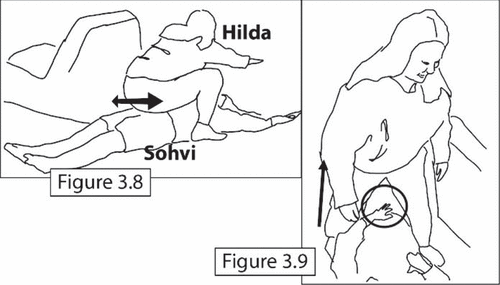
During the following final squat, Hilda grinds into Sohvi’s abdomen, rolling and bouncing (Figure 3.8), and Sohvi produces several strain or pain sounds, including a quiet and creaky “qaao” sound (Line 15); strain as well as pain sounds regularly begin with a glottal release (Hofstetter et al., Citation2021)). However, as the bouncing intensifies, Sohvi produces a loud, extended glottal onset “Q:AA” cry with creaky voice (Line 16), and Hilda lifts out of the squat just as Sohvi requests for Hilda to stop (). The sudden increase in volume seems to prompt Hilda to end the squat; Sohvi is displaying too much pain to continue. Sohvi immediately next produces actual words (“älä”/don’t, L16), drawing on resources with more conventionalized meaning and through imperative grammar asking to discontinue. Note though that Hilda initiates the removal of her pressure by standing up, just before Sohvi asks for her to stop. In other words, she orients to the problem based on the vocalizations before the lexical request.
During the butt-kisses, Hilda and Sohvi have quite asymmetrical bodily experiences, as Sohvi is very much the patient of Hilda’s actions, lying prone, and with limited ability to move Hilda off her. Hilda can, in a way, play Sohvi’s body like an instrument by squeezing Sohvi’s abdomen. The pressure from Hilda’s body requires Sohvi to sustain abdominal tension, which is releasable each time Hilda stands out of the squat. The releasable pressure creates an opportunity to sound a vocalization and display the tension that was also in the vocal tract, which emerges as strain cries. Although Sohvi could also, in theory, hold the bodily tension and breath when Hilda stands, by releasing it and the cries in time with Hilda’s movements, she takes advantage of the opportunities to display synchronized feedback on pressure created by the squats, and thereby inform Hilda how the squats feel. Hilda has tactile access to how much pressure she is applying to Sohvi, but she has limited access to Sohvi’s experience of being squeezed against the floor. The strain, which is occurring in both their bodies, is co-produced at the point of touch. The touch is, in this sense, a resource for producing the sound that needs muscular strain to launch it, just as the sound is a resource for making sense of the touch.
The laughter particles critically portray Sohvi’s cries as playful (Lines 05, 08, 11). Even when asking Hilda to stop, Sohvi’s turn is infused with laughter (Line 16), thus there is a stepwise transition of the affective stance from just playful to playful and painful. By continuing to include some display of nonseriously receiving the squats, Sohvi also forestalls any interpretation that she is in actual danger. Hilda produces laughter particles as well (Lines 06, 09, 12, 17), although hers are uttered only after Sohvi has produced some form of laughter token. In this way, Hilda withholds treating the action as playful until Sohvi has already done so. Hilda thereby attentively treats Sohvi’s sounds as informing on Sohvi’s current stance toward the squats and whether they advise continuation or cessation. Hilda also has access to Sohvi’s facial expressions (unlike Extracts 1–2), which may provide further feedback, although these were not consistently captured on camera.
In summary, the analysis of Extract 3 shows that whether touch is pleasurable or not is negotiated moment-by-moment by the participants through sound. We argue that vocalizations provide an immediate resource for communicating minute shifts in affective stance, from simply pleasurable to pleasurable and painful. Moreover, given that they are part of the affective-tactile experience, vocalizations accompanying touch can act as an upgrade or indicate urgency in regard to the sensations caused by touch. As compared to facial expression, vocalizations penetrate the sensorial space more vividly than the visual modality does; one can choose (not) to look but one cannot choose (not) to hear, especially during tactile intertwinements. Additionally, the vocal modality has a variety of variables, from voice quality to volume to the choice of word or sound, that both conventionally and iconically display affectual involvement, meanwhile gaze is more limited to “mere” direction.
In addition, this excerpt illustrates the distribution of work between vocalizations and a lexical item (älä), which seems to be deployed as the final device to get Hilda to stop. Vocalizations are particularly fitted to communicate sensation and affect in such bodily entanglements as they can take advantage of the way the pressure on the body contributes to producing sounds. Lexical contributions, on the other hand, can escalate the matter and make specific requests relevant to be complied with. Lexical refusals, however, risk having less playful contingencies, or that one rejects the activity entirely, not just the current intensity or form.
The implications of sounding with touch
In this study, we explored vocalizations that were used together with touch among romantic partners in domestic settings. We documented a range of vocal tract sounds produced during bodily intertwinements and occasioned by different kinds of impact from another person’s body. By scrutinizing the temporal evolution of the sounds alongside the transformations of touch, we showed that vocal resources beyond the lexicon can be used to establish intersubjectivity regarding current sensations. By being organized in relation to specific bodily engagements and timed with changing positions, vocalizations become meaningful in communicating sensations as well as affective stances. Participants treated them as providing immediate information of the sensing body, such as conveying current pleasure or discomfort, thus leading to either the extension or cessation of touch. Whereas the soft mmm occasioned extended engagement in the hug (Extract 1), the vocal performance of choking received a very different reaction, establishing a face-to-face formation for a check (Extract 2).
Importantly, we also showed that it is possible to distinguish between a vocalization of pleasure versus discomfort based on a very subtle set of differences (Extract 3), and that this is in no way reliant on just a single acoustic feature, such as breathiness (cf., Anikin, Citation2020). Vocalizations are indexical of the body in a much more holistic sense and emerge in multimodal behavior. The laryngeal and respiratory constriction sounds may convey urgent concerns with breathing, but producing these sounds in the context of bodily squeezing provides a basis for making sense of the vocalizations in a different playful manner. Meaning evolves alongside bodily engagements, and the precise temporal evolution of bodily configurations is as important as their overall interactional context. It is not only that vocalizations are minimally conventionalized, but that the feelings themselves are not straightforwardly or consistently categorizable as pleasure or pain; participants need flexible resources, like nonlexical vocalizations, to display these subtleties. At the same time, in these vocalizations we see evidence of how marginally linguistic tokens are occasioned in coordinated action across participants, thus providing evidence of the dialogic nature of vocal behavior as arising from mutual collaboration rather than merely individual minds. This offers opportunities for a change of perspective from monological to dialogic conceptualizations of all language.
The results of our study paint a nuanced picture of how affect is communicated through vocal resources during interpersonal touch. Vocalizations constitute omnipresent and visceral opportunities to signal the current sensation of the body, and constitute one way of negotiating consent to touch in intimate relationships. Instead of merely relying on emotional expressions visible on our faces (e.g., Darwin, Citation1872; Ekman & Friesen, Citation1969; Mayo et al., Citation2018), or explicit verbal messages such as “yes,” “no,” or “stop,” we find that the communication about the sensations involved in touch often unfolds partially through nonlexical vocalizations. Our study shows that vocalizing is an informative part of touching and communicating affect: Sounds are a part of the tactile-affective experience, on the one hand, and indexical signs communicating about that experience, on the other. As such, they emerge as intercorporeally established “emotional stances” (Goodwin et al., Citation2012) toward the ongoing activity. Given their status as “liminal signs” (Dingemanse, Citation2020), the inherent vagueness of nonlexical vocalizations avoids making face-threatening verbal prohibitions, but also facilitates displaying sincerity (Weatherall et al., Citation2021; Wiggins, Citation2002).
We do not want to deny the importance of explicit, lexicalized refusals that also exist in our dataset. Given that they halt the progressivity of touch all at once, words seem to fulfill a different interactional task from nonlexical vocalizations (as shown in Extract 3); they have different accountabilities. Importantly, in this article we have only discussed safe and trusting relationships. Verbal or nonlexical refusals to touch may not have the same effect in unsafe relationships or situations. Even if our instances did not include direct invitations to sexual intimacy, our study corroborates earlier findings that the negotiation of intimate touch is a context-specific matter (e.g., Kitzinger & Frith, Citation1999) and does not always include explicit consent to touch. Instead, we find that in close romantic relationships, bodily boundaries and thus the right for bodily autonomy can momentarily blur, especially during tactile-affectionate moments such as presented in this study. Participants’ accountability to an activity and to displaying intimacy requires highly nuanced, flexible resources in order to communicate not wanting a specific touch, or not that touch now, rather than disaffiliating from the touching person or the touching activity as a whole. Vocalizations can have a role in affirming ongoing willingness to be touched (as with the ‘mm’s in Extract 1 and the laughter in Extract 3), and participants are sensitive to how such vocalizations, their timing, and bodily coordination display an affective stance to the activity and willingness to progress. This observation suggests that an affirmative consent model should recognize the central role of nonlexical vocal displays.
Finally, our results advance knowledge on the multisensoriality and intercorporeality of affective encounters in intimate relationships, and especially the interplay between auditory and tactile resources. Whereas previous interaction studies in this field (Goodwin, Citation2017; Goodwin & Cekaite, Citation2018) have primarily focused on the emergence of positive responses to touch (however, see an expectation on touch between mothers and children; Katila, Citation2018), our study establishes a nuanced picture of dynamically changing stances toward ongoing touch, showing instances of vagueness and step-wise transitions from less to more problematic displays, or even expressions of pain.
Moreover, the analysis of actual video-recorded events allows one to study how the intercorporeality of bodies (Merleau-Ponty, Citation1968) is accomplished in the complex reality of everyday intimate partnerships, wherein tasks such as cooking and relaxing on a sofa may be interlaced with affectionate moments. Although we “know” other bodies and the meaning they are producing through our own bodily experiences (Meyer et al., Citation2017), we can still never determine exactly how a particular touch feels in another body. Nonlexical vocalizations seem to play a key role in conveying the feeling, being of interactional value: They enable a local resource for participant meaning making and social production of sensations. This supports the scholarship that has begun to uncover the social-interactional organization of senses (Goodwin, Citation2017; Mondada, Citation2021). Given the close connection between touch and vocalizations we documented in the analysis, our study strongly suggests that, rather than being mere responses or additions to touch, vocalizations are, in a carnal way, part of the tactile co-experience.
Acknowledgments
This study was supported by Emil Aaltonen Foundation Post Doc grant, “When love is not enough: Touch and affective practices as resources for a successful romantic relationship,” the Swedish Research Council grant, “Vocal practices for coordinating human action” VR2016-00827, and a grant by Riksbankens Jubileumsfond, “Sounding for others,” P21-0447. We also want to thank Elise Rehula for drawing the pictures for the transcripts. Thank you also for the guidance and insights of the anonymous reviewers. Thank you to the participants for enabling this work.
Disclosure statement
No potential conflict of interest was reported by the authors.
Correction Statement
This article was originally published with errors, which have now been corrected in the online version. Please see Correction (http://dx.doi.org/10.1080/08351813.2024.2313923)
Additional information
Funding
References
- Anikin, A. (2020). The link between auditory salience and emotion intensity. Cognition and Emotion, 34(6), 1246–1259. https://doi.org/10.1080/02699931.2020.1736992
- Burdelski, M., & Cekaite, A. (2020). Control touch in caregiver–child interaction: Embodied organization in triadic mediation of peer conflict in Swedish and Japanese. In C. Asta & M. Lorenza (Eds.), Touch in social interaction (pp. 103–123). Routledge.
- Burkett, M., & Hamilton, K. (2012). Postfeminist sexual agency: Young women’s negotiations of sexual consent. Sexualities, 15(7), 815–833. https://doi.org/10.1177/1363460712454076
- Chen, R. S. Y. (2022). Improvisations in the embodied interactions of a non-speaking autistic child and his mother: Practices for creating intersubjective understanding. Cognitive Linguistics, 33(1), 155–191. https://doi.org/10.1515/cog-2021-0047
- Coy, M., Kelly, L., Vera-Gray, F., Garner, M., & Kanyeredzi, A. (2016). From ‘no means no’ to ‘an enthusiastic yes’: Changing the discourse on sexual consent through sex and relationships education. In V. Sundaram & H. Sauntson (Eds.), Global perspectives and key debates in sex and relationships education: Addressing issues of gender, sexuality, plurality and power (pp. 84–99). Palgrave Macmillan UK. https://doi.org/10.1057/9781137500229_6
- Darwin, C. (1872). The expression of the emotions in man and animals. Murray.
- Debrot, A., Stellar, J. E., MacDonald, G., Keltner, D., & Impett, E. A. (2021). Is touch in romantic relationships universally beneficial for psychological well-being? The Role of attachment avoidance. Personality and Social Psychology Bulletin, 47(10), 1495–1509. https://doi.org/10.1177/0146167220977709
- Di Paolo, E. A., Cuffari, E. C., & De Jaegher, H. (2018). Linguistic bodies: The continuity between life and language. MIT Press.
- Dingemanse, M. (2020). Between sound and speech: Liminal signs in interaction. Research on Language and Social Interaction, 53(1), 188–196. https://doi.org/10.1080/08351813.2020.1712967
- Edvardsson, J. D., Sandman, P.-O., & Rasmussen, B. H. (2003). Meanings of giving touch in the care of older patients: Becoming a valuable person and professional. Journal of Clinical Nursing, 12(4), 601–609. https://doi.org/10.1046/j.1365-2702.2003.00754.x
- Ekman, P., & Friesen, W. V. (1969). The repertoire of nonverbal behavior: categories, origins, usage, and coding. Semiotica, 1(1), 49–98. https://doi.org/10.1515/semi.1969.1.1.49
- Field, T. (2014). Touch, second edition. MIT Press.
- Gallace, A., & Spence, C. (2010). The science of interpersonal touch: An overview. Neuroscience & Biobehavioral Reviews, 34(2), 246–259. https://doi.org/10.1016/j.neubiorev.2008.10.004
- Gardner, R. (2001). When listeners talk: Response tokens and listener stance. John Benjamins. https://doi.org/10.1075/pbns.92
- Goffman, E. (1955). On face-work. Psychiatry, 18(3), 213–231. https://doi.org/10.1080/00332747.1955.11023008
- Goffman, E. (1956). The presentation of self in everyday life. Doubleday.
- Goffman, E. (1961). Encounters: Two studies in the sociology of interaction. Bobbs-Merrill Company.
- Goffman, E. (1963). Behaviour in public places: Notes on the social order of gatherings. The Free Press.
- Goffman, E. (1978). Response cries. Language, 54(4), 787. https://doi.org/10.2307/413235
- Goffman, E. (1981). Forms of talk. University of Pennsylvania Press.
- Goico, S., Gan, Y., Katila, J., & Goodwin, M. H. (2021). Capturing multisensoriality: Introduction to a special issue on sensoriality in video-based fieldwork. Social Interaction. Video-Based Studies of Human Sociality, 4(3), Article 3. https://doi.org/10.7146/si.v4i3.128144
- Goodwin, M. H. (2017). Haptic sociality: The embodied interactive constitution of intimacy through touch. In C. Meyer, J. Streeck, & J. S. Jordan (Eds.), Intercorporeality: Emerging socialities in interaction (pp. 73–102). Oxford University Press.
- Goodwin, M. H., & Cekaite, A. (2018). Embodied family choreography: Practices of control, care, and mundane creativity. Routledge.
- Goodwin, M. H., Cekaite, A., & Goodwin, C. (2012). Emotion as stance. In A. Peräkylä & M.-L. Sorjonen (Eds.), Emotion in interaction (pp. 16–41). Oxford University Press.
- Grahn, I.-L., Lindholm, C., & Huhtamäki, M. (2023). Accounting for changes in series of vocalisations – Professional vision in a gym-training session. Journal of Pragmatics, 212(2), 72–86. https://doi.org/10.1016/j.pragma.2023.05.006
- Gratier, M., & Apter-Danon, G. (2009). The improvised musicality of belonging: Repetition and variation in mother-infant vocal interaction. In M. Stephen & T. Colwyn (Eds.), Communicative musicality: Exploring the basis of human companionship (pp. 301–327). Oxford Academic.
- Gronert, N. M., & Raclaw, J. (2019). Contesting the terms of consent: How university students (dis)align with institutional policy on sexual consent. Gender and Language, 13(3), 291–313. https://doi.org/10.1558/genl.34939
- Gulledge, A. K., Gulledge, M. H., & Stahmannn, R. F. (2003). Romantic physical affection types and relationship satisfaction. The American Journal of Family Therapy, 31(4), 233–242. https://doi.org/10.1080/01926180390201936
- Halley, J. (2016). The move to affirmative consent. Signs: Journal of Women in Culture and Society, 42(1), 257–279. https://doi.org/10.1086/686904
- Hepburn, A., & Potter, J. (2012). Crying and crying responses. In A. Peräkylä & M.-L. Sorjonen (Eds.), Emotion in interaction (pp. 195–211). Oxford University Press.
- Hertenstein, M. J. (2002). Touch: Its communicative functions in infancy. Human Development, 45(2), 70–94. https://doi.org/10.1159/000048154
- Hofstetter, E. (2020). Nonlexical “Moans”: Response cries in board game interactions. Research on Language and Social Interaction, 53(1), 42–65. https://doi.org/10.1080/08351813.2020.1712964
- Hofstetter, E., & Keevallik, L. (2023). Prosody is used for real-time exercising of other bodies. Language & Communication, 88, 52–72. https://doi.org/10.1016/j.langcom.2022.11.002
- Hofstetter, E., Keevallik, L., & Löfgren, A. (2021). Suspending syntax: Bodily strain and progressivity in talk. Frontiers in Communication, 6. https://doi.org/10.3389/fcomm.2021.663307
- Holmström, C., Plantin, L., & Elmerstig, E. (2020). Complexities of sexual consent: Young people’s reasoning in a Swedish context. Psychology & Sexuality, 11(4), 342–357. https://doi.org/10.1080/19419899.2020.1769163
- Husso, M. (2003). Parisuhdeväkivalta: Lyötyjen aika ja tila. Vastapaino.
- Jean, A. D. L., & Stack, D. M. (2009). Functions of maternal touch and infants’ affect during face-to-face interactions: New directions for the still-face. Infant Behavior & Development, 32(1), 123–128. https://doi.org/10.1016/j.infbeh.2008.09.008
- Jenkins, L. (2015). Negotiating pain: The joint construction of a child’s bodily sensation. Sociology of Health & Illness, 37(2), 298–311. https://doi.org/10.1111/1467-9566.12207
- Karvonen, U., Routarinne, S., & Tainio, L. (2023). “Don’t touch”: Negotiating the boundaries of acceptable touching in classrooms. Learning, Culture and Social Interaction, 41, 100730. https://doi.org/10.1016/j.lcsi.2023.100730
- Katila, J. (2018). Touch between mother and child as affective practice: Reproducing affective inequalities in haptic negotiations of bodily borders and the interpersonal space. In T. Juvonen & M. Kolehmainen (Eds.), Affective inequalities in intimate relationships (pp. 201–217). Routledge.
- Katila, J., & Cekaite, A. (2023). Trajectories of love: Affective reciprocity during kissing in the everyday life of romantic couples. Journal of Pragmatics, 214, 38–53. https://doi.org/10.1016/j.pragma.2023.06.010
- Keevallik, L. (2020). When a dance hold becomes illegitimate. In A. Cekaite & L. Mondada (Eds.), Touch in social interaction: Touch, language, and body (pp. 124–149). Routledge.
- Keevallik, L. (2023). Strain grunts and the organization of participation. In L. Mondada & A. Peräkylä (Eds.), Body, participation, and the self: New perspectives on Goffman in language and interaction (pp. 139–167). Routledge.
- Keevallik, L., Hofstetter, E., Weatherall, A., & Wiggins, S. (2023). Sounding others’ sensations in interaction. Discourse Processes, 60(1), 73–91. https://doi.org/10.1080/0163853X.2023.2165027
- Keevallik, L., & Ogden, R. (2020). Sounds on the margins of language at the heart of interaction. Research on Language and Social Interaction, 53(1), 1–18. https://doi.org/10.1080/08351813.2020.1712961
- Kelly, M. A., Nixon, L., McClurg, C., Scherpbier, A., King, N., & Dornan, T. (2018). Experience of touch in health care: A Meta-ethnography across the health care professions. Qualitative Health Research, 28(2), 200–212. https://doi.org/10.1177/1049732317707726
- Kitzinger, C., & Frith, H. (1999). Just say no? The use of conversation analysis in developing a feminist perspective on sexual refusal. Discourse & Society, 10(3), 293–316. https://doi.org/10.1177/0957926599010003002
- Kolehmainen, M., & Kinnunen, T. (2019). Touch and affect: analysing the archive of touch biographies. Body and Society, 25(1), 29–56.
- Kuroshima, S. (2020). Therapist and patient accountability through tactility and sensation in medical massage sessions. Social Interaction: Video-Based Studies of Human Sociality, 3, 1. https://doi.org/10.7146/si.v3i1.120251
- Levinson, S. C. (2006). On the human “interaction engine.” In N. J. Enfield & S. C. Levinson (Eds.), Roots of Human Sociality: Culture, Cognition and Interaction (pp. 39–69). Berg Publishers.
- Lidman, S. (2021). Familial control, collectivity and gendered shame: Past and present vulnerabilities. In M. Husso, Karkulehto, S., Saresma, T., Laitila, A., Eilola, J., & Siltala, H. (Eds.), Violence, gender and affect: Interpersonal, institutional and ideological practices (pp. 28–48). Palgrave Macmillan.
- Linell, P. (2009). Rethinking language, mind, and world dialogically: Interactional and contextual theories of human sense-making. Information Age Publishing.
- Maclaren, K. (2014). Touching matters: Embodiments of intimacy. Emotion, Space and Society, 13, 95–102. https://doi.org/10.1016/j.emospa.2013.12.004
- Magnusson, S., & Stevanovic, M. (2023). Sexual consent as an interactional achievement: Overcoming ambiguities and social vulnerabilities in the initiations of sexual activities. Discourse Studies, 25(1), 68–88. https://doi.org/10.1177/14614456221119101
- Mayo, L. M., Lindé, J., Olausson, H., Heilig, M., & Morrison, I. (2018). Putting a good face on touch: Facial expression reflects the affective valence of caress-like touch across modalities. Biological Psychology, 137, 83–90. https://doi.org/10.1016/j.biopsycho.2018.07.001
- McArthur, A. (2019). Pain and the collision of expertise in primary care physical exams. Discourse Studies, 21(5), 522–539. https://doi.org/10.1177/1461445619846707
- Merleau-Ponty, M. (1968). The visible and the invisible. Northwestern University Press.
- Merleau-Ponty, M. (1964). Signs (R. C. McCleary, Trans.) Northwestern University Press.
- Merleau-Ponty, M. (1962). The phenomemology of perception (C. Smith, Trans.). Routledge.
- Meyer, C., Streeck, J., & Jordan, J. S. (Eds.). (2017). Intercorporeality: Emerging socialities in interaction. Oxford University Press.
- Mondada, L. (2018). Multiple temporalities of language and body in interaction: Challenges for transcribing multimodality. Research on Language and Social Interaction, 51(1), 85–106. https://doi.org/10.1080/08351813.2018.1413878
- Mondada, L. (2019). Contemporary issues in conversation analysis: Embodiment and materiality, multimodality and multisensoriality in social interaction. Journal of Pragmatics, 145, 47–62. https://doi.org/10.1016/j.pragma.2019.01.016
- Mondada, L. (2021). Orchestrating multi-sensoriality in tasting sessions: Sensing bodies, normativity, and language. Symbolic Interaction, 44(1), 63–86. https://doi.org/10.1002/symb.472
- Mondada, L., Monteiro, D. T., & Tekin, B. (2020). The tactility and visibility of kissing: Intercorporeal configurations of kissing bodies in family photography sessions. In Touch in Social Interaction (pp. 54–80). Routledge.
- Montagu, A. (1971). Touching: The human significance of the skin. Columbia University Press.
- Muehlenhard, C. L., Humphreys, T. P., Jozkowski, K. N., & Peterson, Z. D. (2016). The complexities of sexual consent among college students: A conceptual and empirical review. The Journal of Sex Research, 53(4–5), 457–487. https://doi.org/10.1080/00224499.2016.1146651
- Nishizaka, A. (2016). Syntactical constructions and tactile orientations: Procedural utterances and procedures in massage therapy. Journal of Pragmatics, 98, 18–35. https://doi.org/10.1016/j.pragma.2016.04.004
- Nomikou, I. (2023). Joining actions through effort sounds: Mothers and infants in routine activities. Language & Communication, 91, 32–45. https://doi.org/10.1016/j.langcom.2023.05.001
- Popova, M. (2019). Sexual Consent. MIT Press.
- Rączaszek-Leonardi, J., Główka, K., Nomikou, I., & Rossmanith, N. (2022). Time-to-smile, time-to-speak, time-to-resolve: Timescales for shaping engagement in language. Language Sciences, 93, 101495. https://doi.org/10.1016/j.langsci.2022.101495
- Reynolds, E. (2017). Description of membership and enacting membership: Seeing-a-lift, being a team. Journal of Pragmatics, 118, 99–119. https://doi.org/10.1016/j.pragma.2017.05.008
- Roald, T., Levin, K., & Køppe, S. (2018). Affective incarnations: Maurice Merleau-Ponty’s challenge to bodily theories of emotion. Journal of Theoretical and Philosophical Psychology, 38(4), 205–218. https://doi.org/10.1037/teo0000101
- Sauter, D. A., Eisner, F., Calder, A. J., & Scott, S. K. (2010). Perceptual cues in nonverbal vocal expressions of emotion. Quarterly Journal of Experimental Psychology, 63(11), 2251–2272. https://doi.org/10.1080/17470211003721642
- Slater, A. (2002). Visual perception in the newborn infant: Issues and debates. Intellectica, 1(34), 57–76.
- Smith Stover, C. (2005). Domestic violence research: What have we learned and where do we go from here? Journal of Interpersonal Violence, 20(4), 448–454. https://doi.org/10.1177/0886260504267755
- Streeck, J. (2013). Interaction and the living body. Journal of Pragmatics, 46(1), 69–90. https://doi.org/10.1016/j.pragma.2012.10.010
- Streeck, J., Goodwin, C., & LeBaron, C. (Eds.). (2011). Embodied interaction: Language and body in the material world. Cambridge University Press.
- Trevarthen, C. (1979). Communication and cooperation in early infancy: A description of primary intersubjectivity. In M. Bullowa (Ed.). In Before speech: The beginning of interpersonal communication (pp. 321–347). Cambridge University Press.
- Trevarthen, C. (2012). Communicative musicality: The human impulse to create and share music. In D. Hargreaves, D. Miell, & R. MacDonald (Eds.), Musical imaginations: Multidisciplinary perspectives on creativity, performance and perception (pp. 259–284). Oxford University Press.
- Trevarthen, C., & Aitken, K. J. (2001). Infant intersubjectivity: Research, theory, and clinical applications. The Journal of Child Psychology and Psychiatry and Allied Disciplines, 42(1), 3–48. https://doi.org/10.1017/S0021963001006552
- Weatherall, A. (2023). “Oh my god that would hurt”: Pain cries in feminist self-defence classes. Language & Communication, 90, 1–13. https://doi.org/10.1016/j.langcom.2023.01.004
- Weatherall, A., Keevallik, L., La, J., Dowell, T., & Stubbe, M. (2021). The multimodality and temporality of pain displays. Language & Communication, 80, 56–70. https://doi.org/10.1016/j.langcom.2021.05.008
- Wiggins, S. (2002). Talking with your mouth full: Gustatory mmms and the embodiment of pleasure. Research on Language & Social Interaction, 35(3), 311–336. https://doi.org/10.1207/S15327973RLSI3503_3
- Wiggins, S. (2013). The social life of ‘eugh’: Disgust as assessment in family mealtimes: Disgust as assessment in family mealtimes. British Journal of Social Psychology, 52(3), 489–509. https://doi.org/10.1111/j.2044-8309.2012.02106.x
- Wiggins, S., & Keevallik, L. (2021). Parental lip-smacks during infant mealtimes: Multimodal features and social functions. Interactional Linguistics, 1(2), 241–272. https://doi.org/10.1075/il.21006.wig
- Wiggins, S., & Keevallik, L. (2023). Transformations of disgust in interaction: The intertwinement of face, sound and the body. Social Interaction. Video-Based Studies of Human Sociality, 6(2), Article 2. https://doi.org/10.7146/si.v6i2.134841
Appendix
Table A1. Mondada Transcription Symbols

